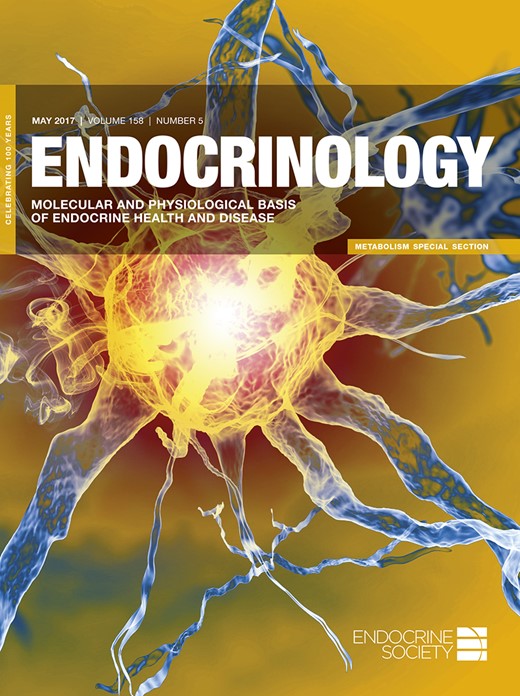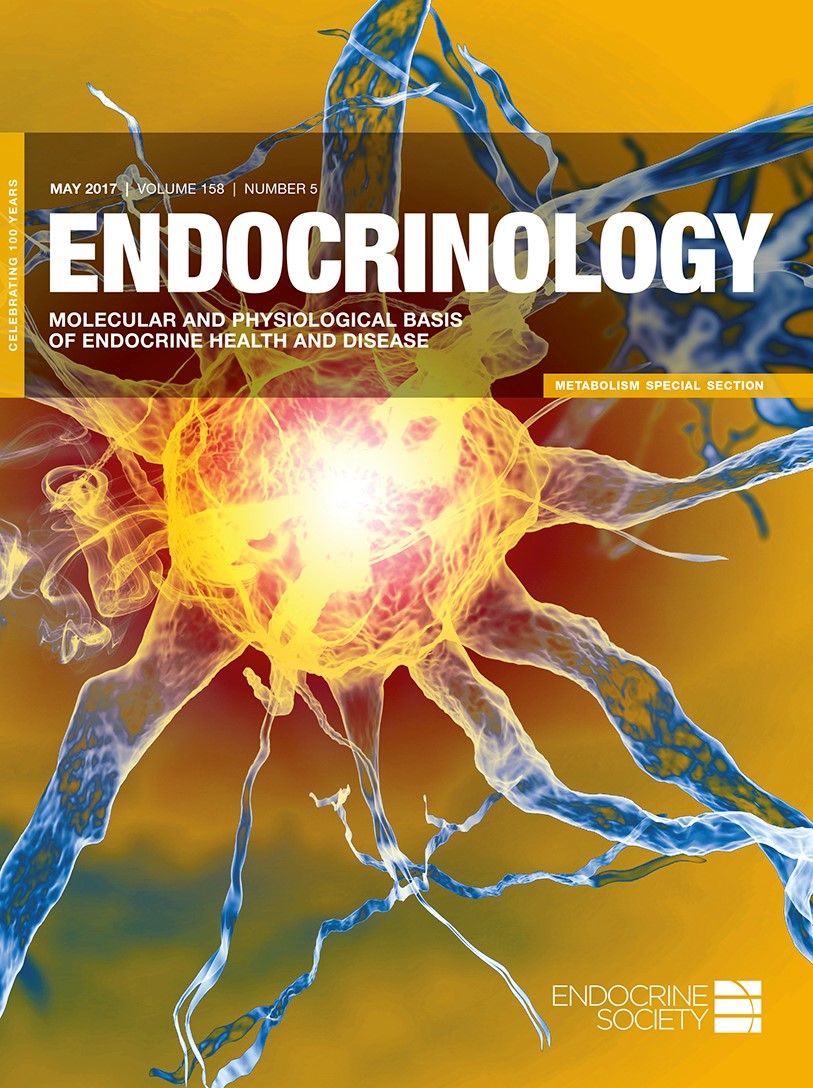
Cover image

Volume 158, Issue 5, 1 May 2017
Special Section: Metabolism in Endocrine Health and Disease
Mini-Reviews
Diabetes, Pancreatic and Gastrointestinal Hormones
The Diverse Metabolic Roles of Peripheral Serotonin
Review of the emerging endocrine roles of peripheral serotonin.
Impaired “Glycine”-mia in Type 2 Diabetes and Potential Mechanisms Contributing to Glucose Homeostasis
Glycine is a potential biomarker for type 2 diabetes. The contribution of reduced glycine to impaired glucose control remains unclear. We review potential impacts in the brain, pancreas, and elsewhere.
Glucose Homeostasis: Regulation by Peripheral Circadian Clocks in Rodents and Humans
This review summarizes recent findings on the molecular and cellular makeup of the circadian timing system and its implications in temporal coordination of glucose metabolism in health and disease.
Energy Balance - Obesity - Metabolism
Novel Hypothalamic Mechanisms in the Pathophysiological Control of Body Weight and Metabolism
This review summarizes recent findings about the role of the central nervous system in the control of energy balance.
Sex Hormones and Cardiometabolic Health: Role of Estrogen and Estrogen Receptors
A brief detailed overview of the literature from basic science to human clinical trials supporting a protective role of estrogens, specifically signaling through ERα, in cardiometabolic health.
News and Views
Calcium Metabolism - Bone
PTH Regulation of FGF23 Fragments: A Tail in Two Acts
Energy Balance - Obesity - Metabolism
Getting the Skinny on Follistatin and Fat
Chewing the Fat: A Metabolic Role for Ldb1 Beyond the Pancreas?
Thyroid Function And Regulation
Beam Me In: Thyroid Hormone Analog Targets Alternative Transporter in Mouse Model of X-Linked Adrenoleukodystrophy
Rapid Communication
Energy Balance - Obesity - Metabolism
Neurosecretory Protein GL, a Hypothalamic Small Secretory Protein, Participates in Energy Homeostasis in Male Mice
This report represents the characterization of precursor protein, localization, distribution, and biological action of neurosecretory protein GL (NPGL) in the mouse hypothalamus.
Research Articles
Calcium Metabolism - Bone
Acute Parathyroid Hormone Injection Increases C-Terminal but Not Intact Fibroblast Growth Factor 23 Levels
Parathyroid hormone injection increases FGF23 production and cleavage in mice.
Development
Hepatic Insulin Resistance and Altered Gluconeogenic Pathway in Premature Baboons
Neonatal baboons received serial hyperinsulinemic-euglycemic clamps. When born preterm, altered hepatic insulin signaling, decreased PEPCK mRNA, and decreased endogenous glucose production was found.
Developmental Basis of Adult Disease
Assisted Reproductive Technologies Predispose to Insulin Resistance and Obesity in Male Mice Challenged With a High-Fat Diet
ART-induced endothelial dysfunction, when challenged with a metabolic stress, facilitates glucose intolerance and insulin resistance.
Diabetes - Insulin - Glucagon - Gastrointestinal
Whole-Body Vibration Mimics the Metabolic Effects of Exercise in Male Leptin Receptor–Deficient Mice
We compared the effects of exercise and whole-body vibration in obese and nonobese mice. The results indicate that whole-body vibration mimics the effects of exercise on metabolism in obese mice.
Diabetes, Pancreatic and Gastrointestinal Hormones
Long-Chain Free Fatty Acid Receptor GPR120 Mediates Oil-Induced GIP Secretion Through CCK in Male Mice
GPR120 contributes to oil-induced GIP secretion in mice by enhancing CCK secretion, whereas GPR40 contributes more greatly and is involved in both CCK-dependent and -independent GIP secretion in vivo.
Endocrine Organ Physiology and Pathophysiology
Hyperhomocysteinemia Promotes Insulin Resistance and Adipose Tissue Inflammation in PCOS Mice Through Modulating M2 Macrophage Polarization via Estrogen Suppression
Treatment of female mice with DHEA induced PCOS-like symptoms. HHcy may exaggerate IR in the PCOS-like mice, most likely via the estrogen-mediated imbalance of macrophage M1/M2 polarization.
Energy Balance - Obesity - Metabolism
Endogenous Calcitonin Gene-Related Peptide Regulates Lipid Metabolism and Energy Homeostasis in Male Mice
Effects of CGRP on metabolic function were analyzed using CGRP−/−, which showed resistance to obesity with higher expression of β3-adrenergic receptor and higher glycerol release from adipose tissue.
Liver NF-κB-Inducing Kinase Promotes Liver Steatosis and Glucose Counterregulation in Male Mice With Obesity
NIK was conditionally deleted in mice. Deletion of NIK in the liver but not hepatocytes or immune cells alone protects against HFD-induced liver steatosis and hepatic glucose production.
Follistatin Targets Distinct Pathways To Promote Brown Adipocyte Characteristics in Brown and White Adipose Tissues
Follistatin promotes brown adipocyte characteristics by targeting distinct pathways in white and brown adipose tissues.
Hypoxia-Inducible Lipid Droplet–Associated Is Not a Direct Physiological Regulator of Lipolysis in Adipose Tissue
We found, using in vivo and in vitro gene silencing and overexpression, that the lipid droplet–associated protein HILPDA is not a physiological regulator of adipocyte lipolysis.
ANGPTL8 Blockade With a Monoclonal Antibody Promotes Triglyceride Clearance, Energy Expenditure, and Weight Loss in Mice
This study describes a specific and efficacious blocking monoclonal antibody to ANGPTL8 that lowers circulating triglycerides in mice and nonhuman primates.
Short-Term Versus Long-Term Effects of Adipocyte Toll-Like Receptor 4 Activation on Insulin Resistance in Male Mice
Lack of adipocyte TLR4 signaling gives rise to a complex metabolic phenotype with improved resistance to acute exposure to saturated fats, whereas it is detrimental upon prolonged HFD exposure.
Loss of Action via Neurotensin-Leptin Receptor Neurons Disrupts Leptin and Ghrelin-Mediated Control of Energy Balance
We investigated how energy cues engage the lateral hypothalamus, and reveal that leptin-sensing neurotensin neurons are hubs for hormone-mediated control of ingestive and locomotor behaviors.
LDB1 Regulates Energy Homeostasis During Diet-Induced Obesity
We report that the Ldb1 transcriptional coregulator has roles in energy homeostasis, in part through transcriptional modulation of critical regulators of brown adipose tissue function.
A Selective Bombesin Receptor Subtype 3 Agonist Promotes Weight Loss in Male Diet-Induced–Obese Rats With Circadian Rhythm Change
We identified a novel BRS-3 agonist, compound-A, and possible mechanism of antiobesity effects modulating circadian rhythm and activation of the HPA axis via SCN.
Protein Translation and Modification
A Novel Fc-FGF21 With Improved Resistance to Proteolysis, Increased Affinity Toward β-Klotho, and Enhanced Efficacy in Mice and Cynomolgus Monkeys
An engineered FGF21 with improved pharmacokinetic, pharmacodynamic, and pharmaceutical properties was developed for the treatment of type 2 diabetes and obesity.
Thyroid Function and Regulation
A Thyroid Hormone–Based Strategy for Correcting the Biochemical Abnormality in X-Linked Adrenoleukodystrophy
Thyroid hormone and the thyromimetic sobetirome lower CNS levels of very long chain fatty acids in a mouse model of X-linked adrenoleukodystrophy supporting a therapeutic strategy for X-ALD.
Additional Research Articles
Adrenal Function and Regulation
Postnatal Ontogeny of the Circadian Expression of the Adrenal Clock Genes and Corticosterone Rhythm in Male Rats
In rat adrenals, the assessment of clock genes expression ontogeny revealed a progressive postnatal maturation of clock genes circadian variation in synchrony with corticosterone circadian rhythm.
Calcium Metabolism - Bone
Molecular Physiology of the Hypocalcemic Action of Fibroblast Growth Factor 23 in Zebrafish (Danio rerio)
FGF23 and calcium regulation in zebrafish.
Developmental Basis of Adult Disease
Vasoprotective Activities of the Adrenomedullin-RAMP2 System in Endothelial Cells
We assessed the actions of the AM-RAMP2 system using a vascular injury model and demonstrated this system exerts vasoprotective effects and is a novel therapeutic target for vascular diseases.
Diabetes - Insulin - Glucagon - Gastrointestinal
Vessel Network Architecture of Adult Human Islets Promotes Distinct Cell-Cell Interactions In Situ and Is Altered After Transplantation
Three-dimensional analysis revealed that endogenous human islets exhibit a distinct vascular network that promotes specific cell-cell interactions of islet cells and substantially alters after transplantation.
Growth Hormones - Growth Factors
Activation of Male Liver Chromatin Accessibility and STAT5-Dependent Gene Transcription by Plasma Growth Hormone Pulses
Igf1, Cish, and a subset of male-biased liver genes undergo rapid pulsatile increases in chromatin accessibility and gene transcription with each male plasma GH pulse–induced cycle of STAT5 activation.
Insulin, IGF-1, and GH Receptors Are Altered in an Adipose Tissue Depot–Specific Manner in Male Mice With Modified GH Action
This article shows that the expressions of GH, IGF-1, and insulin receptors in mouse AT are affected by modified GH action. Furthermore, receptor expressions occur in a depot-dependent manner.
Neuroendocrinology
Protective Effects of Fetal Zone Steroids Are Comparable to Estradiol in Hyperoxia–Induced Cell Death of Immature Glia
Fetal zone steroid (FZS)–mediated neuroprotection was similar to that of E2 in a preterm hyperoxia model. In the presence of FZSs, there was no synergism with E2 treatment in two of three cell types.
Circulating Ghrelin Acts on GABA Neurons of the Area Postrema and Mediates Gastric Emptying in Male Mice
The capacity of circulating ghrelin to induce gastric emptying in mice requires the integrity of the area postrema, which contains a population of GABA neurons that are the target of plasma ghrelin.
Pituitary
Elucidating the Role of the Desmosome Protein p53 Apoptosis Effector Related to PMP-22 in Growth Hormone Tumors
PERP and desmosome components are dysregulated in sparsely granulated GH tumors. In vitro studies suggest that downregulation of PERP plays an important role in sparsely granulated tumorigenesis and survival.
Reproduction, Sex, and Gender
Demonstration of a Functional Kisspeptin/Kisspeptin Receptor System in Amphioxus With Implications for Origin of Neuroendocrine Regulation
The Kiss-Kissr system was identified in amphioxus. Kiss can interact with Kissr, induce zebrafish LH release, and increase amphioxus gpb5 expression. Also, Kiss/Kissr is down-regulated after spawning.
The Steroid Metabolome in the Isolated Ovarian Follicle and Its Response to Androgen Exposure and Antagonism
Steroid metabolome analysis by mass spectrometry in the isolated ovarian follicle revealed early developmental capacity for androgen synthesis, which was upregulated by androgen receptor antagonists.
Steroid Hormone Actions
Genome-Wide Identification of Basic Helix–Loop–Helix and NF-1 Motifs Underlying GR Binding Sites in Male Rat Hippocampus
A stressful experience does not influence GR binding in the hippocampus relative to nonstressed controls. Insights into GR binding mechanisms include support via basic helix–loop–helix and NF-1 motifs.
Thyroid Function and Regulation
N-Acetylcysteine Prevents Low T3 Syndrome and Attenuates Cardiac Dysfunction in a Male Rat Model of Myocardial Infarction
Restoring redox balance by NAC treatment prevents NTIS-related thyroid hormone derangement and preserves heart function in rats subjected to MI.
Transcription - Gene Regulation
NeuroD Factors Discriminate Mineralocorticoid From Glucocorticoid Receptor DNA Binding in the Male Rat Brain
Genome-wide identification of corticosteroid receptor binding loci on the DNA suggests that at MR-exclusive binding sites, NeuroD factors cooperate with MR binding and/or functionality.


